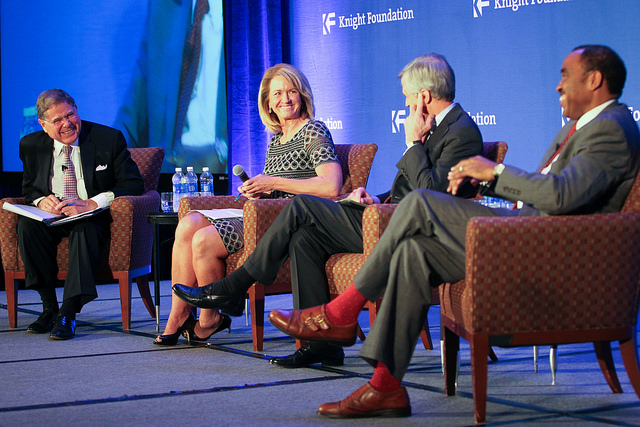
Journalism as knowledge: covering solutions to strengthen communities
Above: David Bornstein. Photo credit: Knight Foundation on Flickr.
Community foundations can play an essential role in highlighting information that solves problems in their cities, said New York Times journalist David Bornstein during Knight Foundation’s 2014 Media Learning Seminar.
Bornstein is co-founder of Solutions Journalism Network, a nonprofit trying to shift the focus of storytelling in the media to explore more efforts and projects that work.

RELATED LINKS
“4 new community information investments focus on high-impact projects” by Marika Lynch on KnightBlog.org
“Embracing change: Five key lessons from innovative community foundations” by Elise Hu on KnightBlog.org
“How to open up the data in your community to help solve problems” by Elise Hu on KnightBlog.org
“How to apply human-centered design at home: Lessons from the Media Learning Seminar” by Elise Hu on KnightBlog.org
“Strengthening communities: The case for talent, opportunity and place” by Elise Hu on KnightBlog.org
“Going for Goal: Shared knowledge inspires successful Giving Days” by Bahia Ramos on KnightBlog.org
“Using design thinking for community information needs” by Marika Lynch on KnightBlog.org
“2014 tech trends that will impact foundations” by Elise Hu on KnightBlog.org
“Join us – virtually – for a conversatino on community news and information” by Marika Lynch on KnightBlog.org
“Solutions journalism is rigorous, evidence-driven reporting about responses to problems,” he said, and community foundations can help “map out the landscape of innovation” and make sure reporters know about responses to problems in the community. Foundations, in fact, are “a natural bridge,” he said, between the public and media.
Bornstein spoke to attendees along with Michael Maness, Knight Foundation vice president for journalism and media innovation.
He agreed that community foundations can help overcome “a real disconnect between local media and communities.”
“Big media … favors high-impact, low-probability events,” such as shootings and natural disasters, Maness said. “That makes it very difficult to tackle the kind of problems most communities face on a daily basis.”
Bornstein said most journalists are uncomfortable writing about solutions, which they may misinterpret as advocacy, and focus on uncovering problems and writing accountability stories. That process may ignore the hundreds of responses to problems that emerge in communities.
“It’s not just people doing terrible things that are hidden from view,” he said. “People are doing remarkable things, and those are secrets too. Those are secrets we need to unmask.”
Community foundations can also share information about community solutions through their peer networks across geographical boundaries, which may especially benefit rural areas with fewer connections.
“The solution to a challenge in your town may be in someone else’s town,” he said.
Bornstein co-writes the New York Times Fixes column in the New York Times, which explores solutions for social problems, with journalist Tina Rosenberg. They began the network more than a year ago with author Courtney Martin, a regular Fixes contributor. The nonprofit, which is supported by Knight Foundation and other funders, has a staff of about 10 working with a network of newsrooms, colleges and freelancers to introduce the approach “into the water supply of journalism,” he said.
News stories often involve tension, the clash of opposing sides, Bornstein said. But the most important tension is in the “how” questions, he said: How will a problem be solved? How will people overcome obstacles that may be in the way?
Bornstein warned, however, that there are several types of stories that may masquerade as solutions journalism. They include stories that suggest silver bullet solutions, or that media report at the tail end of a series or project, suggesting the information is not the most important area of focus. By contrast, solutions journalism stories go “deep and take resources to do well,” he said.
Bornstein said the Solutions Journalism Network has worked with about 30 organizations, including the Center for Investigative Reporting, the McClatchy Company and the Seattle Times, which is pursuing Education Lab, a yearlong project “about education solutions in the Pacific Northwest.”
The network is also a recent winner of Knight News Challenge: Health, for a project that will explore stories and solutions buried within health databases and then help get the information into the hands of policymakers.
Bornstein observed that people will pay tens of thousands of dollars on formal education, but they’re reluctant to pay for the cost of accessing news online. Solutions journalism can help change the equation.
“People don’t consider journalism knowledge,” he said, “but we can make it knowledge.”
For more information on the Solutions Journalism Network, read this blog post by Marie Gilot of Knight Foundation. For information on the network’s News Challenge: Health project, read this blog post by Tina Rosenberg.
Michael D. Bolden, editorial director at Knight Foundation
Recent Content
-
Communitiesarticle ·
-
Communitiesarticle ·
-
Communitiesarticle ·


